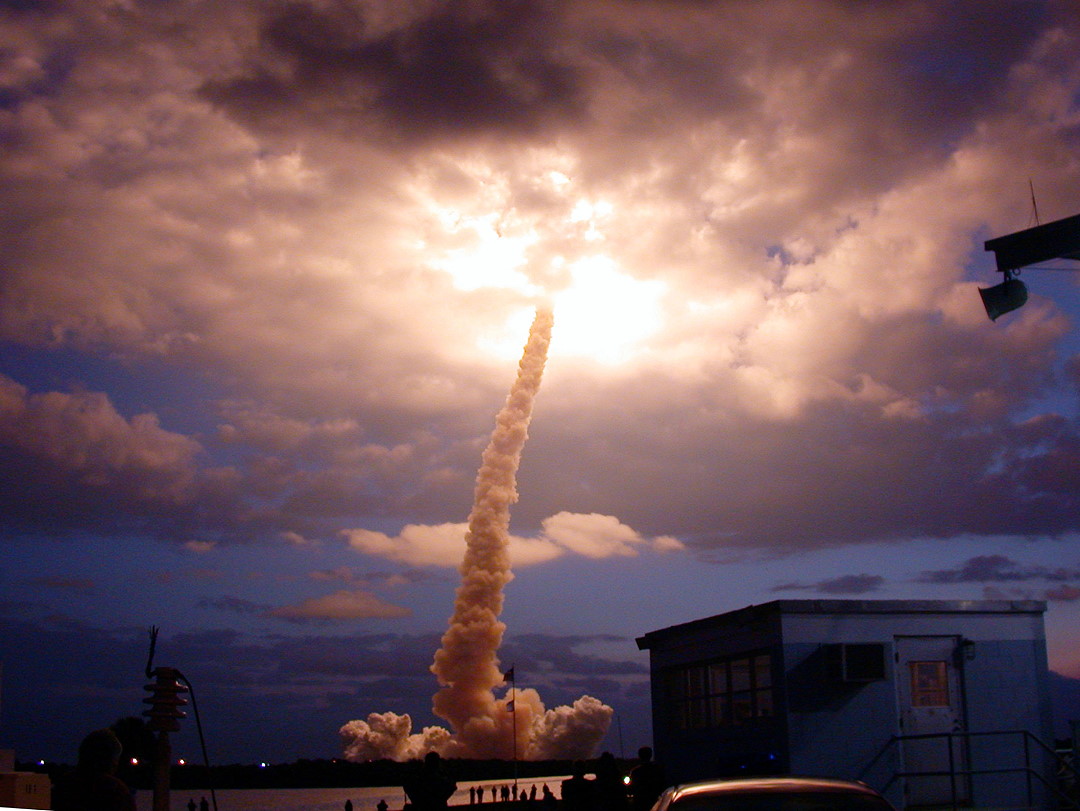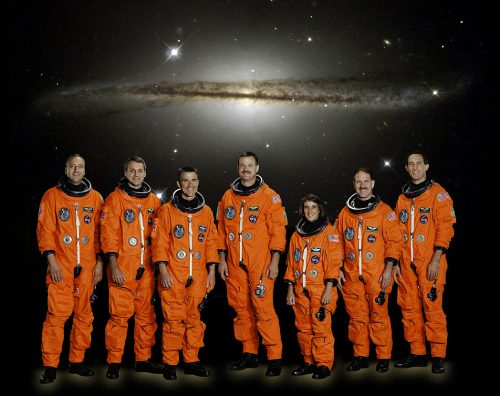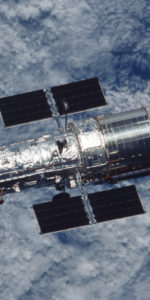
Rising into the pre-dawn darkness on 1 March 2002—15 years ago, next week—Space Shuttle Columbia’s 27th mission into low-Earth orbit would achieve, literally, the greatest heights of her storied career. In more than two decades of operational service, she had flown the shortest and longest shuttle missions and had become the first crewed orbital vehicle to be commanded by male and female pilots. But in March 2002, on her last wholly-successful mission before her untimely loss, Columbia would travel to an altitude of 360 miles (580 km) to repair and service NASA’s iconic Hubble Space Telescope (HST) for the fourth time. Operating in a low-Earth orbital domain more than 100 miles (160 km) higher than Columbia’s previous missions, Hubble would see the queen of the Space Shuttle fleet reach the highest altitude in her career.
As outlined in yesterday’s AmericaSpace history article, STS-109 was the fourth servicing visit to Hubble, although it was numerically designated Servicing Mission (SM)-3B. It formed the second half of what was originally conceived as a single shuttle flight. In July 1998, NASA assigned crew members to support a record-breaking six EVAs to install the new solar arrays, new instruments and perform other upgrades. Planned for June 2000, unanticipated failures aboard Hubble caused the SM-3 mission to be split into two, with “SM-3A” performing the most critical work to keep the telescope functional in December 1999 and “SM-3B” following a couple of years later to carry out the remaining tasks. John Grunsfeld had flown aboard 3A and it made sense to retain his expertise on the 3B crew.
Joining him were astronauts Rick Linnehan, Jim Newman and Mike Massimino, with the quartet working in two alternating pairs to execute five sessions of Extravehicular Activity (EVA). Rounding out the seven-strong STS-109 crew were Commander Scott “Scooter” Altman, Pilot Duane “Digger” Carey and flight engineer Nancy Currie, the latter of whom would operate Columbia’s Remote Manipulator System (RMS) mechanical arm to capture and redeploy Hubble and support the EVAs. By the time STS-109 roared away from Pad 39A at the Kennedy Space Center (KSC) in Florida, just before dawn on 1 March 2002, the astronauts had been training together for more than a year. By the time Columbia reached orbit, they boasted no less than 20 spaceflights between them.

However, all was not well with the shuttle herself. Less than 90 minutes into the flight, the payload bay doors were opened to reveal sluggish performance from one of two freon coolant loops. It later transpired that a small fragment of foreign debris had gotten stuck in the loop, briefly raising the possibility of a premature return to Earth, although this did not prove necessary. Meanwhile, the astronauts pressed ahead with critical maneuvers to reach Hubble, all the while wrestling with other problems. Columbia’s airlock hatch handle—which had given trouble to the extent of canceling an EVA on a previous flight—proved stubborn, but was eventually fixed by Newman.
Early on 3 March, the shuttle completed its rendezvous and Currie extended the RMS and grappled the telescope, before anchoring it into Columbia’s payload bay. The operation required all seven astronauts, with Altman flying the vehicle, backed-up by Carey, Newman on the laptop computer providing situational awareness calls, Linnehan operating the hand-held laser rangefinder, Currie and Massimino running the RMS and Grunsfeld overseeing the Hubble communications procedures. High above the Pacific Ocean, to the southwest of Mexico, the two spacecraft finally met for five days of servicing activities.
“Houston, we have Hubble on the arm!” radioed Altman.
“Copy, Scooter,” replied Capcom Mario Runco from the Mission Control Center (MCC) at the Johnson Space Center (JSC) in Houston, Texas. “Outstanding work.”
Ahead lay five complex EVAs, the first pair of which were conducted on 4 and 5 March. For EVA-1, Grunsfeld and Linnehan were tasked with swapping out one of Hubble’s roller-blind-like solar arrays and replacing it with a smaller, rigidized and higher-capacity version. Then, on EVA-2, Newman and Massimino would do likewise for the other array. Each measuring 39 feet (12 meters) in length, both of the old arrays were retracted without incident. After almost a decade in orbit by March 2002, they provided only 63 percent of their original power output, whereas the new arrays—which measured 23 feet (7 meters) in length and folded out, like the halves of a book—provided 30 percent more power, generating 5,270 watts as opposed to the 4,600-watts peak load of their predecessors.
Grunsfeld was the only member of the STS-109 crew who had visited Hubble before; a self-confessed “Hubble Hugger”, he would go on to fly STS-125 in May 2009 and today stands as the only human to have visited the telescope in orbit as many as three times. He introduced himself to “Mr. Hubble”, then declared that he had come “to give you more power to see the planets, stars and the Universe”.
Without further ado, Grunsfeld and Linnehan marched through the removal of the starboard-side array, stowed it and installed a diode box to ensure that power from the soon-to-be-fitted new array flowed directly to the telescope’s batteries. Early the following morning, Newman and Massimino set to work on the port-side array, completing the task swiftly and also replacing a reaction wheel, which had encountered difficulties a few months earlier. Validation tests from the Space Telescope Operations Control Center at NASA’s Goddard Space Flight Center (GSFC) in Greenbelt, Md., confirmed that both solar arrays and the new reaction wheel were behaving as expected.
Next up, on EVA-3, Grunsfeld and Linnehan were tasked with replacing Hubble’s Power Control Unit (PCU), effectively executing complex “heart surgery” on the telescope. The day began ominously, with a water leak from Grunsfeld’s space suit, requiring him to swap for a backup suit before the spacewalk began. Eventually, two hours later than timelined, the astronauts emerged from Columbia’s airlock—marking the first occasion that as many as three EVAs had been performed from the queen of the shuttle fleet—and got to work. Delicately, they cut off power to Hubble’s six batteries, setting off a time-critical eight hours to complete the PCU changeout.

Complicating the procedure was the bulkiness of the cables, which made the 36 electrical connectors extremely difficult to reach. In fact, they were so tightly spaced that Grunsfeld and Linnehan needed to use a wrench, rather than their gloved hands, to get to them. Five hours into EVA-3, the PCU replacement was complete. “You did it, buddy!” exulted Linnehan. “You did it!” It was truly a significant moment. Although Hubble had been partially powered-down during the SM-1 repairs in December 1993, a total shutdown of the telescope for several hours had not been attempted prior to SM-3B. Altman’s crew were certainly relieved when Runco came back with a post-operative report. “Columbia, Houston,” he told them. “We have a heartbeat!”
In what were described as “masterful performances”, the tone had been amply set for the remainder of the 11-day mission. Before the launch, Grunsfeld joked that failure would mean he could never show his face at meetings of the American Astronomical Society (AAS) again; fortunately, that possibility was now averted. During EVA-4, Newman and Massimino set about the replacement of Hubble’s instruments. They pulled out the Faint Object Camera (FOC)—its sole remaining “original” instrument, in place since the telescope’s launch—and replaced it with the Advanced Camera for Surveys (ACS). The new camera would cover significantly broader patches of the sky, with far greater clarity and speed than had previously been achievable.
With 80 percent of the mission complete, only EVA-5 now remained. And for Carey, making his first spaceflight, there simply was not the option of “coasting” at this stage. He remembered some advice from Nancy Currie: she could only ever relax when she was outside the shuttle, in the bus, heading back to crew quarters, after landing. “One of the main challenges on the mission is to keep that mental focus,” said Carey, “to wake up each morning and say: Okay, this is the big day. And then waking up the next morning and having that same attitude.”
Such an attitude propeled the crew through Grunsfeld and Linnehan’s EVA-5, which saw the installation of a cryocooler to bring the Near-Infrared Camera and Multi-Object Spectrometer (NICMOS)—which had been out of service since early 1999—back to life. At the end of the spacewalk, Grunsfeld wrapped up his sixth EVA on Hubble, more than any other human being. He gave the telescope a farewell tap, convinced that he would never see the telescope again. “But I have been touched by its magic,” he said, “and changed forever.” Little did Grunsfeld know that he would go on to play a major role in the development of the next mission to Hubble…and, in May 2009, would end up flying to the telescope again.
With 35 hours and 55 minutes of spacewalking completed during STS-109, a new record had been established for servicing Hubble, eclipsing the 35 hours and 28 minutes totaled during SM-1. In the meantime, STS-109 was nearing its conclusion. A rejuvenated Hubble was deployed back into space on 9 March 2002 and Columbia herself returned to Earth a few days later. “Wheels Stop, KSC,” radioed Altman, as he guided his ship to a smooth halt on the Shuttle Landing Facility (SLF) at the Kennedy Space Center on the 12th.
It would be Columbia’s last successful homecoming.
During descent, Linnehan—seated on the shuttle’s aft flight deck, in a position to be occupied by Laurel Clark during the STS-107 re-entry—observed the glowing trail of plasma, stretching behind them, as they plunged back to Earth. He managed to acquire the view by means of a hand-held mirror. At one point in the descent, he offered Carey the chance to look in the mirror and see Columbia’s white-hot vertical stabilizer tail. Carey declined.
“No thanks, buddy,” he told Linnehan. “Some things you just don’t want to see!”
STS-109 was lucky. On Columbia’s next flight, her luck tragically ran out.
This is part of a series of history articles, which will appear each weekend, barring any major news stories. Next week’s article will look back at Apollo 9, an unsung mission which played a critical role in validating the spacecraft which would carry men to the Moon.
Be sure to “LIKE” AmericaSpace on Facebook and follow us on Instagram & Twitter!






‘Just as her crew has, Columbia has left us quite a legacy. There’s heavy grief in our hearts, which will diminish with time – but it will never go away – and we won’t ever forget. Hail Rick, Willie, KC, Mike, Laurel, Dave and Ilan. Hail Columbia.’
And another legacy: Dream Chaser
“Sierra Nevada Corporation, the Nevada space services company that put forth the proposal, suggests using its Dream Chaser winged spacecraft for the repair mission. The Dream Chaser is a smaller craft than the Space Shuttle, but similar in overall design. The spaceship is currently undergoing flight tests and development, with a targeted maiden launch in 2019 and the goal of shuttling cargo and science experiments to the ISS shortly after. A Dream Chaser would need to be manufactured with life-support and abort systems to carry astronauts to Hubble, though design plans already exist for a crewed version of the craft.”
‘A New Spaceship Could Fly Astronauts to the Hubble Space Telescope for Repairs
The Trump administration is considering a proposal by Sierra Nevada to refurbish Hubble for the future.’ By Jay Bennett Feb 14, 2017
At: http://www.popularmechanics.com/space/telescopes/a25211/mission-to-service-hubble-space-telescope/